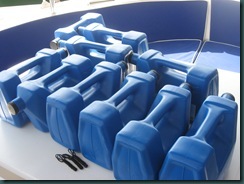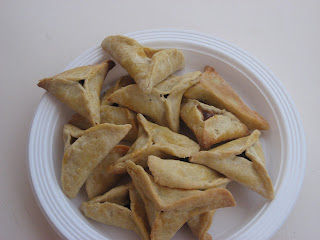This is the diary of our family sailing voyage aboard a 46 Foot Sailing Catamaran. We are Michael and Barb, with our children Danielle and Harrison who were 11 and 8 when we started in October 2009 from San Diego. We've been cruising through Mexico and the next leg of our travels takes us to the South Pacific. You can contact us by email at michael@mitgangs.com or barbg@mitgangs.com.
Thursday, March 31, 2011
The Countdown and Answers to Questions you may have pondered...
WHAT are all these new blogs we've linked to on the right hand side of our blog? These are new and (some old) friends that we've made, plus one up-and-coming cruiser. Hopefully I'll have time to write a blog or two about these friends and who they are. It's actually pretty miraculous that we've made some new friends here in La Cruz in the last 3 weeks given how hectic and busy we've been, but that's cruising. Cruisers seem to form a wonderful warm and inviting community. This is for better or for worse -- on our tight schedule, we've been doing perhaps a bit too much socializing. It's hard to avoid though, and believe me, we're not complaining.
WHEN are we leaving for the South Pacific? The optimum time to leave is during the first two weeks in April. This allows us to take full advantage of the sailing season in between the cyclone (i.e. hurricane) seasons in the South Pacific (November to April). So we plan to be ready around April 1 (yes, that's tomorrow), but given that it is April Fool's Day and a Friday, and given that sailors are very superstitious and won't commence a voyage on a Friday, we plan to leave on the following Tuesday, putting the departure date at Tuesday, April 5. All this is, of course, weather permitting. With such a long voyage, we plan to save as much fuel as possible so do not want to turn on our motors. This means that we'll need enough wind to take us sailing out to about 300 miles off shore, where we'll pick up the trade winds that will carry us west and south. In addition, the Tuesday departure allows us to head to the produce warehouse, which is open on Sunday nights, to choose our 3 week supply of produce. This gives us Monday to stow all the produce, take the boat as required to Nuevo Vallarta to the harbor master to check out of Mexico, and while we're at it we'll fill up with fuel. We'll sleep on the hook (i.e. at anchor) on Monday night so that we can start getting our sea legs. Then Tuesday morning, we'll be off. The countdown is on: That's in only a few short days. It may (and does) feel as though the deadline has just been sprung on us, but we have been preparing for a while, even while we weren't sure we were going. But then again, we are experts at getting ready in a short time - you may recall that we bought the boat, moved aboard, and got it ready in 6 weeks...
WILL we be taking crew? We've decided not to take crew. The decision was not taken lightly. We deliberated a long time on this one, and while another crew member could help with the night time watches, we have weighed that against the fact that we have a good crew already in the four of us. We also took into account the fact that it's a long time to have someone on your boat, especially if it doesn't work out. It's not just the three week passage, because you'd need to let that crew off in a place where's there's enough civilization for him/her to get home - like an airport - which is likely three months into the trip. As far as our current crew (i.e. our family), we've had the kids take day watches before, and we may add an 8-10 p.m. watch for Danielle. Plus, after a few days, you get used to the night watches. If it were just Michael and I, we would definitely take crew. But with the four of us on board, there's always an extra set of eyes or hands if absolutely necessary. For example and in the worst case scenario, if someone goes overboard, we have at least two other sets of eyes to keep a watch out for the person who fell in, while someone else can still drive the boat (we have practiced man overboard drills in the past, and plan to on our way to Nuevo Vallarta before checking out). Our kids have really grown into fine crew members, and I'm looking forward to the time together with nothing to do but school, play games, and hang out together.
WHAT's our route? We don't know. We think we'll follow the route known as the Coconut Milk Run, but exact places and dates can and almost positively will change. So, tentatively, it looks like this:
April - Passage to the Marquesas
April/May - Marquesas Islands (French Polynesia)
May - Tuamotu Islands (French Polynesia)
June - Society Islands including Tahiti, Bora Bora, Moorea (French Polynesia)
Late June/early July - Cook Islands (Suwarrow in the north or Rangaroa in the south)
July - Nuie
Late July/early August - Tonga
Late August to late September - Fiji
Late September/ Early October -Vanuatu
October - New Caledonia
End of October - Make landfall in Bundeberg, Australia
November/December - Explore Australia
But as with all our plans, they are fluid...
-Barb in La Cruz (for only a few more days...)
Wednesday, March 30, 2011
Lists, Lists, Lists …. Getting Shorter, Shorter, Shorter…
As we are now into our final week of preparation our lists are beginning to get shorter. Of course, we have lists of lists and even as they get shorter new tasks are added. That said, we are getting close. We have had our rig inspected by a rigger and our engines serviced. We have our paper charts and electronic charts. We have loaded electronic charts on two computers and have backed up our hard drives. We have gotten our entry visas/permits for French Polynesia and have changed our navigation coverage with our insurance company. We have reviewed the weather fax information we will be able to receive while underway and have even given our blog a facelift which now includes the ability to track our progress – provided all our communication systems work and are able to send updates.
In the process, we came upon two ‘situations’ that needed addressing.
We updated our emergency beacon transponder information (known as EPIRB’s - we have two) with the US Coast Guard and have tested them both. In the process we decided to speak to the manufacturer about the life of the built-in batteries on the beacons given that the expiry date was one month ago, and we’ll still be cruising for another 6-8 months. The manufacturer informed us this was fine and there is no need to replace it in the near future – we’ll keep testing it every month. During the conversation however, he inquired about the age of our hydrostatic release mechanism (this automatically deploys the beacon if the release mechanism is submerged a few feet underwater). In the course of our conversation he had no concern with the battery life of our beacon but was concerned that the release mechanism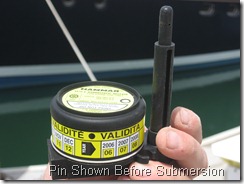 would not work as it had likely expired. So, we ordered a new one from West Marine – the Nordstrom of the boating world – and our good friends on Safety Cat, who were visiting family in the US, brought it down for us. We installed the new one and decided to see what would happen with the old one if we submerged it. So, we took a break from homeschooling and went out to the dock and started spraying it with water. Nothing happened. It needs to be submerged!!
would not work as it had likely expired. So, we ordered a new one from West Marine – the Nordstrom of the boating world – and our good friends on Safety Cat, who were visiting family in the US, brought it down for us. We installed the new one and decided to see what would happen with the old one if we submerged it. So, we took a break from homeschooling and went out to the dock and started spraying it with water. Nothing happened. It needs to be submerged!! 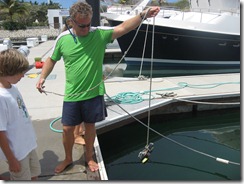 So we tied a rope to it and put it in the water, but it floated! So we added a weight and lowered it about six feet (2 meters) and still nothing happened. We finally lowered it about 15 feet (5 meters) and then they hydrostatic release responded by snapping a pin that, had the beacon been attached would have deployed it. Its good to know how they work and that we replaced ours.
So we tied a rope to it and put it in the water, but it floated! So we added a weight and lowered it about six feet (2 meters) and still nothing happened. We finally lowered it about 15 feet (5 meters) and then they hydrostatic release responded by snapping a pin that, had the beacon been attached would have deployed it. Its good to know how they work and that we replaced ours. 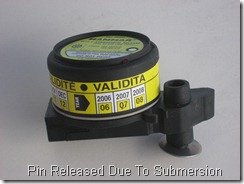 I would not want to be 15 feet underwater before it responded. Though, I have not tested the new one (as I need it) to know for sure at what depth it would respond.
I would not want to be 15 feet underwater before it responded. Though, I have not tested the new one (as I need it) to know for sure at what depth it would respond.
We also had our standing rigging checked. This involved sending an experienced rigger up to the top of our mast who then inspected all the connections. It turned out that everything looked great except for a tiny hairline crack in one of our turnbuckles (this connects the rod rigging to the mast). 
I think we are now almost ready though we still need to get our bottom cleaned (the boat bottom so we can go fast, not our personal bottoms); make a test call on our satellite phone; fill our diesel, gasoline and propane tanks; check smoke and carbon monoxide detectors among other things; and review emergency procedures at sea including the viewing of a life raft deployment. I am sure things will still get added to our list (or our list of lists), but hopefully at a rate now that is slower. We are now also feeling like we are crossing more things off than we are adding.
Michael (in La Cruz)
One of the Idiosyncrasies of Mexico: Grocery shopping
 |
| This is L2 (Locker #2), located in the salon at the table under a seat. |
 |
| Note the 4 bottles of Newman's Own Balsamic Vinaigrette |
Michael and I spent 3 hours of our lives yesterday morning searching for 2 outstanding items from my Ship's Provisioning Log. These items were Newman's Own Balsamic Vinaigrette, a staple in Danielle's diet, as well as canned green beans, for those lonely meals out at sea when all of our fresh produce has been eaten or rotted away. Canned green beans are the only canned veggie my family will eat. I couldn't find them at the two Walmarts I visited, neither at the Mega, Commercial or Costco, nor at the Soriana store at El Caracol Plaza. All searched via bus or on foot, walking miles in the heat.
Why would I spend 3 hours to find these easy-to-find-anywhere-in-North-America items? Mexico has many idiosyncrasies, but one of the more apparent ones is highlighted when one is trying to provision one's boat. The thing about grocery shopping in Mexico is that you may find something somewhere one day, and you may never see it again. But we never would have expected this to happen with items that have been relatively commonplace while we've been cruising in Mexico. You see, I have had these items on my boat all along our cruising route, as they have both been readily available whenever I've needed more. However, for some reason, these items have now become scarce in the Banderas Bay area. We've learned, just in time to leave the country, that if you see it, even if you don't need it yet, you'd better buy it. I'm kicking myself now for allowing our stores to run out.
I finally found the salad dressing at the Soriana across from Walmart by the cruise ship docks. I had never been to that Soriana before and if I were to do it all over again, I'd do all my provisioning there.
Unfortunately, I have not located canned green beans yet. I think I'm done though. Oh so done.
Whatever we've got, we've got. Time to move on to other line items on my To Do list.
-Barb in La Cruz
Tuesday, March 29, 2011
Provisioning III: Where does it all go?
First, you get rid of a lot of the packaging. Next, you get yourself a vacu-sealer. We just got one at Costco, and I’ve now got competition for my husband. Yes, I’ve practically lost him to the
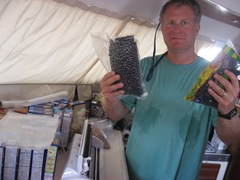 vacu-sealer. He’s vacuum-sealed pasta, dried beans, meat, grains, spices, and then he got into boat parts and batteries. He’s having way too much fun with this thing! But I must say we’ve been sold on it. It not only keeps things much fresher for much longer, but also it makes items take up far less space. Which is what we need: for items not to take up too much space. Because we don’t have much of that.
vacu-sealer. He’s vacuum-sealed pasta, dried beans, meat, grains, spices, and then he got into boat parts and batteries. He’s having way too much fun with this thing! But I must say we’ve been sold on it. It not only keeps things much fresher for much longer, but also it makes items take up far less space. Which is what we need: for items not to take up too much space. Because we don’t have much of that.After much deliberation and filling up our floor boards and all
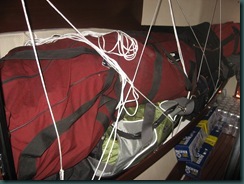 closets, lockers (another term for an area under a seat that stores stuff) and pantry areas, we have filled our duffel bags with food. Three large bags are devoted to cans, and three on top of those are for more fragile items (one for crackers, one for snacks and one for cereals). These we placed on the sea berth, which is a narrow bed located in the port hull for extra sleeping. Michael then installed some brass eyes so that we can rope the bags in so that they won’t fall while we’re underway.
closets, lockers (another term for an area under a seat that stores stuff) and pantry areas, we have filled our duffel bags with food. Three large bags are devoted to cans, and three on top of those are for more fragile items (one for crackers, one for snacks and one for cereals). These we placed on the sea berth, which is a narrow bed located in the port hull for extra sleeping. Michael then installed some brass eyes so that we can rope the bags in so that they won’t fall while we’re underway.  |
| Under the floor boards... |
So ends the bulk of my provisioning. I’ve got a couple of odds and ends still to pick up like art projects for the passage. And then the last of the provisioning will come 2 days before we cut the lines and head out: Twice a week there is a produce warehouse that sells to all the retail tiendas around town, and they open to the public. This is where we’ll get the bulk of our fresh produce for the passage. And then we’ll need a day to prepare it for stowing, and to stow it.
For now I can concentrate on other details. The work’s not yet done.
-Barb in La Cruz
Monday, March 28, 2011
Provisioning II: Off to Shop
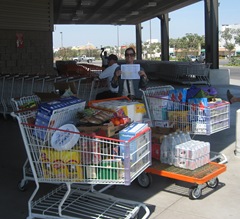 We rented a car for a couple of days to help us with the running around. We started at Costco, because here in Puerto Vallarta it is not accessible by bus. I had also scoped it out before we left for California last month, so I knew what I needed there. Four carts later (including one flatbed), we left. We filled the entire trunk and back seat of our mid-sized car. Note that I am holding my Ship's Provisioning Log in the first photo.
We rented a car for a couple of days to help us with the running around. We started at Costco, because here in Puerto Vallarta it is not accessible by bus. I had also scoped it out before we left for California last month, so I knew what I needed there. Four carts later (including one flatbed), we left. We filled the entire trunk and back seat of our mid-sized car. Note that I am holding my Ship's Provisioning Log in the first photo.Next stop was Walmart, and another two full shopping carts there. Then Mega (one of the main grocery chain stores), a new produce market (just to see what they have – it’s not yet time for produce shopping) and countless other stops. For example, we used the opportunity to run around with the car for boat parts, fishing rod repairs, and other boat supplies, like all the motor oil you see in the photo.
And let’s not forget picking up our kosher meat and Passover order at the airport – 5 boxes worth. Thankfully, no matzah – if you recall my blog from last year, it’s not surprising that I still have matzah leftover from 2010. As a Passover aside: We’ll be on our passage in the middle of the Pacific Ocean for our two seders – which will certainly provide for an interesting blog post then. I’ve also been able to do my Passover cleaning while I’ve been inventorying – I washed out every last storage area with bleach cleaner before putting things back. We don’t want no chametz (leaven) nor do we want any mold.
When placing things into
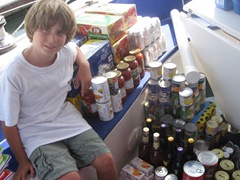 my shopping cart, I had to consider a few details. First, as I mentioned in my last blog, how much should I be buying given that we need to be left with as little as possible at the end of the journey? I tried to calculate how often we eat a certain item, and then went from there. A few examples: Tomato Sauce – I use it in a lot of things like bolognese sauce, stuffed peppers, pasta meals, sweet and sour meatballs, and so on. I calculated I should have about 20 jars for the 6-7 months until we get to Australia. By the time I loaded them into my cart, however, I decided on only 15 jars. Why? Because I’ve been told that everyone over-provisions. So I’m trying to account for that with most things: I’ll slightly underestimate, and I’m sure we’ll still have enough. Another item: Mac & Cheese. NEVER would I have this in my house at home as I try really hard to make sure I understand every ingredient on a food label. But here, when Michael and I are out and the kids have friends over and want to make lunch, it’s an easy one. So I calculated 26 boxes, but bought only 20. Another item: powdered milk. Sounds gross, I know, but when you need only 2 tablespoons of milk for that mac&cheese, I’m not about to open a fresh tetrapak of milk only to have the entire liter spoil on me (we drink very little milk). We still have 6 tetrapaks (i.e. unrefrigerated) of milk, just in case. Also on this same vein is that liquid items are pure weight, so if we can go with a dry solution, that’s optimum. We have very little in the way of beverages on board – we’ll drink mostly water or water flavored with C-light – thanks to our water maker.
my shopping cart, I had to consider a few details. First, as I mentioned in my last blog, how much should I be buying given that we need to be left with as little as possible at the end of the journey? I tried to calculate how often we eat a certain item, and then went from there. A few examples: Tomato Sauce – I use it in a lot of things like bolognese sauce, stuffed peppers, pasta meals, sweet and sour meatballs, and so on. I calculated I should have about 20 jars for the 6-7 months until we get to Australia. By the time I loaded them into my cart, however, I decided on only 15 jars. Why? Because I’ve been told that everyone over-provisions. So I’m trying to account for that with most things: I’ll slightly underestimate, and I’m sure we’ll still have enough. Another item: Mac & Cheese. NEVER would I have this in my house at home as I try really hard to make sure I understand every ingredient on a food label. But here, when Michael and I are out and the kids have friends over and want to make lunch, it’s an easy one. So I calculated 26 boxes, but bought only 20. Another item: powdered milk. Sounds gross, I know, but when you need only 2 tablespoons of milk for that mac&cheese, I’m not about to open a fresh tetrapak of milk only to have the entire liter spoil on me (we drink very little milk). We still have 6 tetrapaks (i.e. unrefrigerated) of milk, just in case. Also on this same vein is that liquid items are pure weight, so if we can go with a dry solution, that’s optimum. We have very little in the way of beverages on board – we’ll drink mostly water or water flavored with C-light – thanks to our water maker.The next consideration is the weight of all this food. When we first brought all our provisions aboard, our starboard hull was much lower in the water than our port side. We’ve since been able to even it out. But it’s not only making sure that the food is evenly distributed on both sides, and that the stern (back) of the boat is heavier than the bow (front). It’s the total weight as well. I’m not sure our boat will move with all this food aboard. The water line is likely 2 inches higher, meaning the boat is sitting much lower in the water. An interesting math activity for when we get bored on our crossing would be to add up all the weight of the food on my Ship’s Provisioning Log. I hope you know I’m kidding.
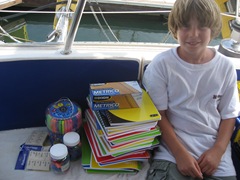
Harrison posing with some of the school supplies we hope to bring to some of the schools we visit.
Finally, there’s the packaging to consider. You’d think that plastic would be preferred over glass on a boat. Yes, glass can break, but on the other hand, it’s easier to dispose of when at sea. Any glass gets filled with water so that it will sink and then thrown overboard. Think about all that beautiful colored sand on the beaches you find! We also have to get rid of all cardboard packaging as one defense against cockroaches, which love the glue and to lay eggs in corrugated cardboard. Without the cardboard to create a skeleton-like armor around fragile food like crackers and cereals, we’ll be eating a lot of crumbs by the end of this trip.
As another aside, I’ve touched on what we do with trash at sea. All paper gets torn into little pieces and gets thrown overboard. All cans get filled with water and sunk to disintegrate at the bottom of the sea. I’ve already mentioned glass. And of course all food stuff becomes fish food. That leaves all plastic for our garbage. We’ll stow a green garbage bag in the engine compartment for when we make landfall. Hopefully, we’ll have very little.
Next blog: Where and how to stow it all.
- Barb in La Cruz
Sunday, March 27, 2011
Let the Provisioning Begin
Where does one begin provisioning for a long passage? The task seemed even more overwhelming than when we left San Diego for Mexico in October of 2009. Our next voyage will be at least 3 weeks long, but we need to provision for an even longer period of time since food availability is minimal in most places, and when it is available, it is pricey. My friend Behan on s/v Totem (currently in Australia) just emailed me that a dozen eggs in the South Pacific will set us back about $6. She also blogged about spending $12 on a melon, because her crew hadn’t seen fresh produce for a while.
Back to where one starts. Several blogs and the Pacific Puddle Jumpers’ website offer spreadsheets, as do several of my cruising reference books. I opted for recreating the wheel, so to speak. Well, not quite. When we came down to Mexico in October of 2009, I had created a list of things we ate for breakfast, lunch and dinner, and shopped based on this list. The list has now become my reference sheet for provisioning. By the way, you will cook and eat on board the same way you have always cooked and eaten. Just because you’ve moved onto a boat, that won’t change. As in, don’t start buying dried beans to cook in your pressure cooker if you’ve never eaten dried beans before, and better yet, rarely if ever use your pressure cooker. Although I’d recommend you start before you move aboard, as it is so much easier on your pocket book.
Okay, again, back to where one starts. I began my provisioning this time by taking an inventory of everything I had on the boat in the way of food, cleaning and washing supplies, medicines and toiletries. Talk about a tedious job. I was feeling depressed as Michael was crossing things off his list left and right, while I was still drowning in the hulls below the floor boards with my inventory sheet day after day. Alas, it did get completed.
From the work-of-art known as my Inventory List, for items we use often, I made an estimate of how often we eat it. For example, I make 3 cups of long grain brown rice at least once per week. Multiply this by 26 weeks and we need a lot of rice. This gets tricky, since long grain rice is hard to come by in some places in Mexico, but it is doable. For other items, I have just been winging it. Like for soya sauce, or BBQ sauce, or for so many other items. Do I get one extra bottle, or stick with what we have?
This gets even trickier since we want to be left with almost nothing by the time we make landfall in Australia in 6-7 months. The reason for this is that the quarantine rules are very stringent: the authorities will search your boat and take away things like fresh meat, vegetables and dairy, but more importantly, any dried beans, rice and grains, plant sources and even canned meats like tuna. Then, hopefully, a few weeks after making landfall in Australia, anything that’s left must be made 'gone' if we are successful in selling our dear boat there. Yet provisioning is not an exact science. And there’s that psychological aspect that you MUST have enough food or YOU’LL STARVE. It has one wonder what people living on these islands eat, no?
Okay, so back to getting the provisioning started. This inventory exercise took me a full week to complete. I now have a 17 page document that lists every item on my boat, including the quantities, and where they are stored. A little overboard, perhaps, but it's done, and I'm loving the accomplishment, not to mention the system and how it works.
Next blog: Heading out to shop.
-Barb in La Cruz
Saturday, March 26, 2011
Fun Quotes Aboard Whatcha Gonna Do
As we get ready for a very long offshore passage there are a few funny lines that either Barb or I have said to our kids these last couple of week:
1. “Eat ice cream!” -- So, as we have begun to provision we have been loading the boat with enough food to hopefully last us 6 – 8 months since it is difficult to get the types of foods we are used to and at reasonable prices in the islands of the South Pacific. In addition, Barb just made a huge order of kosher meat from Mexico City that all needed to find a home in our freezer. So with that, we instructed our kids to eat all the remaining ice cream in the freezer (not that there was that much) to make room for the meat.
2. “Do not read a book …. go watch a movie!” -- We have been accumulating books for our passage and, while Danielle has been dying to read 4th though 7th Harry Potter books, we have told her she cant read them now. She seems to be able to finish them in a couple of days. And, while we are on shore power, it is easy to watch movies since we are plugged in. So, with that she has not been able to read – she needs to save the books for our three week passage. Usually parents take away TV but we take away books!
Who would have ever thought a parent would speak such words!
Michael
In La Cruz, getting ready to cross
Wednesday, March 23, 2011
Charts, Charts, Charts
To begin, we have electronic charts of all of the South Pacific and Australia. They will take us wherever we need to go, and have great detail as you zone in on entrances to atolls or harbors or anchorages. But there is always a risk that your electronics will crash due to a lightning strike, or just plain no reason at all. We also have cruising guides which include local detail for the more popular cruising spots. Some of these guides are electronic, and some are paper. So it’s always prudent to be sure to have backups in the way of paper charts for wherever you think you may be going.
We started with some good overview charts to assist us in plotting our course. We have a large one that covers the whole central and south Pacific Ocean from Mexico to Australia. We’ll likely chart our course on this one as we cross, marking it twice a day. Any more than twice a day will make us feel like we're going backwards.
We then have overview charts of different sets of islands, like a chart that covers the Marquesas to the Tuamotos, and then the Tuamotus to Tonga, and so on. We’ll use those as we make our passages between the islands.
We then have charts of smaller areas of islands, such as just the Marquesas, just Tahiti, and so on. These have a nice amount of detail to get a good overview of what’s out there, but other than for French Polynesia (which we got in a nice small booklet), we do not have charts with good detail for entrances to anchorages. We are hoping our guide books will cover us for those. Having said that, that’s where you can run into trouble with reefs, cones, and other wonders. In addition, charts are not always completely correct, and with the reefs, even being off a foot or two can make all the difference as your depth sounder says you have 20 feet below you and then suddenly you have none. It's for this reason that we know never to enter anchorages when it’s dark. In fact, it's important to enter when the sun is low, either in the morning or in the afternoon, with the sun behind so that it casts a shadow over anything in the water that can cause you trouble. Either Danielle or I will be high up (possibly up the mast) scouring the water for anything that doesn't show up on the charts, ready to shout to our captain that he must back up immediately. And apparently the anchoring is very different in the South Pacific than in your average sandy bottom Mexican bay, because of these coral reefs -- which, I'm sure, will be the subject of a future blog. While this all sounds so daunting to me now, I am sure we'll get used to it. On the bright side, we hear that the visibility in these waters can be as much as 70 feet.
Back to the charts. So where do we find the charts we need? We started at the nautical book stores in the Bay Area when we were there a few weeks ago but didn’t get very far. Had we had more time, we could have ordered a set of everything the experts think we’d need from a wonderful service called Bellingham Charts. But we knew that there were resources, less expensive although not as convenient, in Banderas Bay.
When we got back, we met with other cruising friends who have sailed the South Pacific to see what they had and what they felt was most important to have. Our friends on s/v Blue Sky were an amazing help. In addition, at Marina Vallarta, Steve on s/v Kavenga has an incredible lending library in his land home. Michael and I spent 3 hours in his ‘chart room’ (i.e. his bedroom) – he stores all the charts in order under his bed. We spent a lot of time in giggle/exhaustion mode: How are we supposed to know what we need? And then once deciding on the approach, how are we supposed to pronounce the names of all these islands (Tahaa, Upua Oa, Malitiki, Hiva Oa, Fatu Hiva…), let alone the names of the bays and anchorages and towns and cities? Which anchorage goes with which island? Which island goes with which country/island group? This is certainly a lesson in geography. We'll have several weeks at sea to figure it all out.
Another interesting side note: Some of the charts we looked at date back to the 1800's.
We got through the chart sorting exercise and we now think we have what we need. So, many bus rides, hours and hundreds of dollars later, we think we can check ‘charts’ off our list.
Onto the next item.
-Barb, in La Cruz de Huanacaxtle, Nayarit, Mexico
Sunday, March 20, 2011
Making Hamentaschen
Yesterday several of Danielle’s friends joined Danielle and I as we made hamentaschen, triangular-shaped cookies filled with a prune mixture, poppy seeds, and jams. These cookies are traditional for the holiday of Purim which is today. The cookies are called “Haman’s Ears” in Hebrew, because they are supposedly shaped like the ears of the Jewish people’s nemesis during the time of Persian King Achashverosh. The story goes that the king married Esther, the niece of Mordechai, a Jew, who was hated by Haman, a minister in the king’s court. When Haman wanted to kill the Jews, Queen Esther boldly went to the King and disclosed that she too would be killed because she was Jewish. The King then reversed the order and had Haman and his 10 sons hung instead. Kind of like a soap opera on steroids. Except that today we rejoice that we were saved, we eat (as in all holidays), we listen to the story of Purim in the Scroll of Esther while we dress up in costumes, and we give out gifts of food to friends. For this year, we shared our hamentaschen.
-Barb in La Cruz
Where has the season gone?
Many boaters spend the summer in the Sea of Cortez, which is what we did last year. Others will keep their boats in a hurricane ‘hole’. This is generally a spot in the middle of where hurricanes can and have hit, but it’s usually a spot that is a natural marina or harbor set inland from the coast (i.e. not a marina created by land fill but rather one that is usually up an estuary). This is important because when the boat is in the water during a hurricane, it’s not so much the wind (although that is a concern), it is very much the ocean surge and swell that causes damage to your boat. A marina that is set far back from the coastline will get less swell.
Still others choose to haul their boats for the summer (called “keeping it on the hard”), often in Guaymas or San Carlos or elsewhere, which means keeping your boat out of the water. These people will go elsewhere to sit out the heat of the Mexican summers, often returning home for several months.
And then there are those like us who are leaving Mexico, heading either South into Central America or West to the South Pacific. This is a busy time for all of us, preparing for the next leg of our voyages.
But where did the time go? It feels like we spent the entire fall getting to Huatulco for our visitors, followed by getting to Puerto Vallarta/La Cruz for our trip to CA for the bat and bar mitzvahs. And then here we are now, preparing for the South Pacific. We have had a blast, but it’s gone way too quickly. We are sad to be leaving Mexico – I feel like I’m not done yet and there’s still so much more to explore. But I know I’ll be back.
And in a few weeks, we’ll be parting ways with friends as they head north or south or somewhere else for the summer; or we’ll be reuniting with other friends as we and they make landfall in the Marquesas Islands of French Polynesia.
-Barb in La Cruz
Saturday, March 19, 2011
Making the Decision
When we were in the Bay Area a few weeks ago, I spent a lot of time talking to teachers at the kids' school (we don't call it their 'old' school because we intend to return there) and they assured me that the challenges we were facing were purely developmental. The teachers gave me pointers and aids on how to deal with the challenges I was having (as an aside: incredible teachers!). I spoke to his peers and realized that he is at the same level they are. And I spoke with friends who have kids that age and/or are teachers, who also assured me that he's doing fine and is right on track. Back to the South Pacific. Sort of.
Now that the kids were on board, Michael and I had to decide if we were ready. 'Ready' is a subjective word. Our boat is undoubtedly ready. But are we? Mentally? Interestingly, I am thoroughly looking forward to the 3 week passage, with nothing to do but homeschool, hang out and play games with my kids, do art projects, do yoga, read, write plenty of blogs and sleep. In addition to being on watch 24/7 (on a schedule of course, sharing it with the rest of my crew). There's no shopping, laundry, dates, internet or other distractions. We'll be completely present. But once we get there??? It's a completely different type of cruising than we've been doing. Passages between the islands are usually 3-7 days. Most of the anchorages are trickier due to coral heads, cones, and the like. You are clearly much more off the beaten track, and what if we need emergency help? Internet connections are spotty and scarce. Fresh produce is even scarcer in many of the destinations. And if you could get past all of the above, there are SHARKS that swim in the anchorages in the Marquesas.
On the other hand, all this is so exciting, and a once in a lifetime experience - for all of us. Other people have managed to overcome all of the above, so why can't we?
So we took a deep breath, and plunged in. We've now set our schedule to depart around April 1, just so that we have a deadline. We're going to the South Pacific ... unless of course, we decide not to between now and then...
Barb
La Cruz de Huanacaxtle, Nayarit, Mexico
Whatcha Gonna Do... With My Wife Barb
Friday, March 18, 2011
Tahiti Send-Off
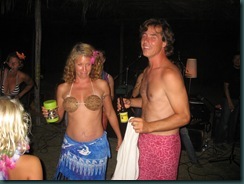

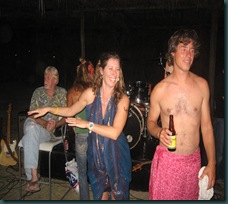
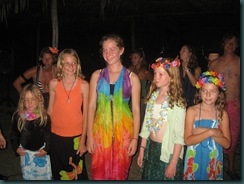

Several of the Puddle Jumpers have already departed. We have a lot to do before our turn. Thus, I’ll keep my post brief.
-Barb
Marina Riviera Nayarit,
La Cruz de Huanacaxtle, Nayarit, Mexico
Sunday, March 13, 2011
Tsunami Warning: A study in Group Think
The VHF radio is a pretty interesting mode of communication in moments like this. One can get a play-by-play of what's going on in all four of the Banderas Bay marinas at the same time. The first thing we heard was that the Port Captain closed all the marinas. This was later updated to say that the ports were closed only to commercial vessels but that recreational vessels were permitted to leave. Some recreational vessels (i.e. crusisers like us) left even while the news was that all ports were closed, and I can't blame them. The worst place for a boat during a tsunami is in a marina. The best place to be is in deep water (i.e. 400+ feet).
It was incredulous to hear some on the VHF saying that last year the tsunami was a non-event and so this year they weren't going to go out to sea. That's like saying that last year we weren't affected by any hurricanes so this year we can ignore any coming our way. After all, last year's tsunami was triggered by an earthquake in Chile, a completely different direction than Japan, and at a lower magnitude. We also heard people saying that since no one was leaving, they weren't going to leave either. Fascinating reasoning.
In the meantime, Michael and I kept monitoring the situation and made our decision to leave the dock, with all our belongings (including hoisting our dinghy), approximately 2 hours before the tsunami was expected to hit, and once we learned from the website that the surge was expected to be in the 3 to 6 foot range with currents up to 14 knots. This means that an extra 3 to 6 feet of water will flow into the marina and then immediately get sucked out, leaving only a few feet below our bottom, within only a few minutes. This also means that if you were using your motor to drive your boat at 8 knots (which is fast for a sailboat), you'd be going backwards 6 knots if the current were going against you. While it would have been fascinating to watch, it was not something we wanted to experience, if in fact it were the worst case scenario. I was most concerned that our boat would get a beating against the docks with all that surge and current. And our philosophy has also always been: if we are thinking about doing it, we should probably just go ahead and do it. We had nothing to lose. And so we were one of the first to leave the La Cruz marina, just as the news of the 3-6 foot surge with 14 knot currents came in over the VHF. I do have to say that I am proud of how Michael and I decision-make in these stressful situations. We stayed calm, weighed the situation, and did what we thought was the most prudent thing we could do, regardless of what everyone else was doing.
The panic continued through out the day as we heard news of Crescent City and Santa Cruz harbors being destroyed, and another earthquake that hit Guatemala. The news of the devastation in Japan kept rolling in as well. We were advised that the 'event' would continue for several hours into late afternoon, and that the marinas would likely be closed during that time due to strong currents. People who stayed in the marina reported seeing eddies and whirlpools that looked like washing machines, and the water levels rising as high as five and a half feet and then back lower in only minutes. One of the docks in Marina La Cruz broke off as a result of the currents, and the electricity and internet went off as well. Luckily, there was no damage reported to any of the boats, other than some refrigeration breaking down due to very silty water going into the refrigeration exchange filters. Everyone in the marinas were then advised to turn all refrigeration off.
The panic reached its peak close to sunset, when, after a beautiful day of sailing, the marinas were still closed. We heard one woman complain that there was no leadership around the whole thing. I'm not sure what she was hoping for. We all got the same information and had to make the decisions that we felt comfortable with. Unfortunately, I do believe that this is part of what's wrong with modern society in America today: people do not take responsibility for their own actions but rather wait for someone else to tell them what they should be doing. [I don't mean to open up a political debate here - there is a lot more wrong than just that!].
The results of the tsunami lasted longer than expected. People who were out sailing wanted to get back in and many were harassing the marina operators over the VHF to let them in. The marina operator at one of the marinas was shouting over the VHF to several sailboats trying to enter: "THE MARINA IS CLOSED. THE MARINA IS CLOSED. DO NOT ATTEMPT TO ENTER!" There was a 'pan-pan' too: one boat lost his motor, and for some reason couldn't raise his sails, claiming he was taking on water. Several boats had removed their anchors from their boats that morning because they were participating in the Banderas Bay Regatta scheduled that day and wanting to get rid of some weight so they could go faster (this is, by the way, against racing rules). This meant they could not anchor out for the night. This meant more panic. It left us wondering how they got their boats down to Mexico in the first place. True, it's not the best scenario to be hanging out all night until daylight, but what's the alternative? There was none, if you ask me. I also believe that this type of panic comes from staying on the dock too long. As cruisers, we need to be prepared all the time to make decisions for our own safety. If we are always on the alert, there are not surprises and no panic.
By the next morning, the marinas re-opened although there was still a tremendous amount of current going into Marina La Cruz. One of the marina operators actually had the nerve to announce to everyone on the VHF that, by the way, none of the large yachts in his marina, all with professional captains, left the marina. This was wholly inappropriate, if you ask me. First, he was judging our decisions to leave the marina when it is a known fact that the best place to be is at sea. People should not be faulted for being cautious. Second, the professional captains don't own their boats so it's easy to take the easy way out and stay put. He did not earn any points from anyone around here.
The moral of the story: Think for yourself. Always be prepared. Stay calm. Be patient.
Our thoughts and prayers go out to the victims of the earthquake and tsunami in Japan. We here in Banderas Bay should be counting our blessings. I know I am.
-Barb
Back in Marina La Cruz (aka Marina Riviera Nayarit)
La Cruz de Huanacaxtle, Nayarit, Mexico
Friday, March 11, 2011
La Cruz Marina Empties Out
Other than a little excitement here there does not appear to be any damage to boats or the coast.
Michael
Anchored just outside La Cruz.
----------
radio email processed by SailMail
for information see: http://www.sailmail.com
Thursday, March 10, 2011
Home, Sweet Boat, Home
 |
| Lauren had a 'psychedelic 60's party for her bat mitzvah |
 |
| The WGD crew |
It's taken us several days to unpack, particularly since we made our return trip with 7 large duffel bags (and a multitude of carry-on bags) full of boat parts, food, clothes, guide books, fiction books, cruising guides and other necessaries for our adventures going forward. We are closer to making a decision to go the South Pacific, but whereas I feel the decision has been made, Michael is not quite there yet. If we do go, we'll be leaving in about 3 weeks' time. This is a common phenomenon among cruisers: Decisions of where and when you go is only final when you leave. For me this is a bit disconcerting; if a decision is hanging for too long while I wait for someone else to come to terms with it, I lose interest. Lots to look at there, I'm sure.
Monday, March 7, 2011
Red Tides
 |
| Delaware |
Did you know that it is possible to predict and track HABs? The National Oceanic And Atmospheric Administration (NOAA) has satellites that scan the water for color, and buoys on the surface of the water and sensors on the ocean floor that sense color and current.
You may be wondering if the Red Tide could have been the first plague, blood, which God sent against Pharoah when he wouldn’t let the Jewish people leave Egypt.
 I was wondering the same thing, so I did some research and found out that it couldn’t be because the Red Tide doesn’t happen in the Nile River because Red Tides only occur in oceans. I thought about this and found a solution: If you look at a map, the Nile River starts in Sudan and then flows into Egypt. That could mean that maybe the Red Sea water levels were higher and the mountains were lower. At the same time, there was a Red Tide, which flowed over the mountains, and into the Nile it went.
I was wondering the same thing, so I did some research and found out that it couldn’t be because the Red Tide doesn’t happen in the Nile River because Red Tides only occur in oceans. I thought about this and found a solution: If you look at a map, the Nile River starts in Sudan and then flows into Egypt. That could mean that maybe the Red Sea water levels were higher and the mountains were lower. At the same time, there was a Red Tide, which flowed over the mountains, and into the Nile it went. Red tides are extraordinary but they can also be dangerous. When we were anchored in Tamarindo Bay in Tenacatita, we saw a real Red Tide. My parents learned that it was okay to swim in it because it wasn’t that bad. It was so interesting so my parents told me to research it.
-Harrison, currently in California for a visit

